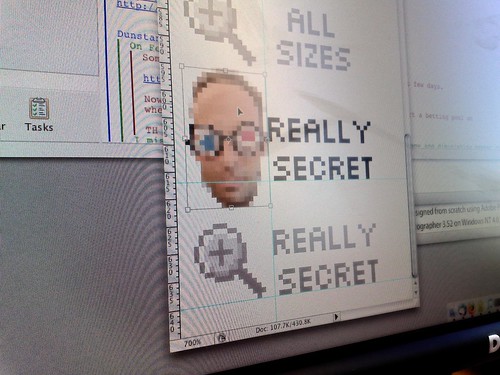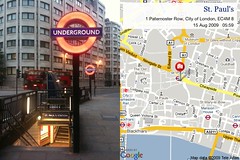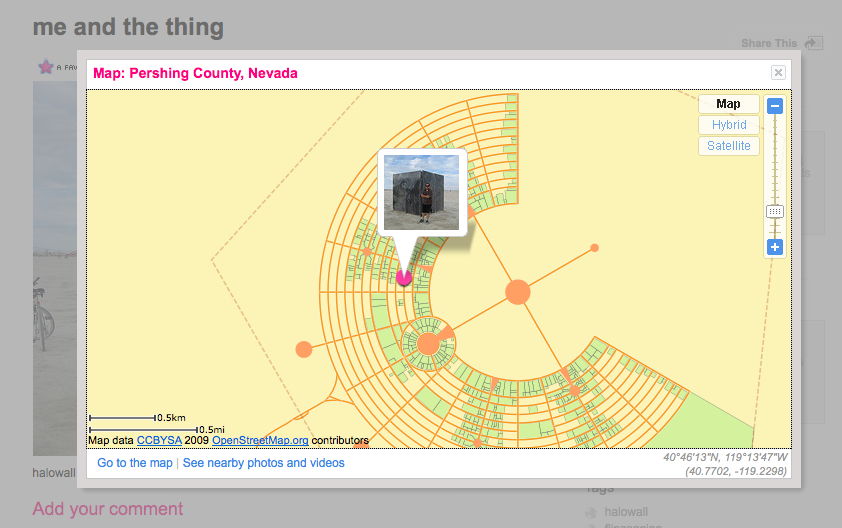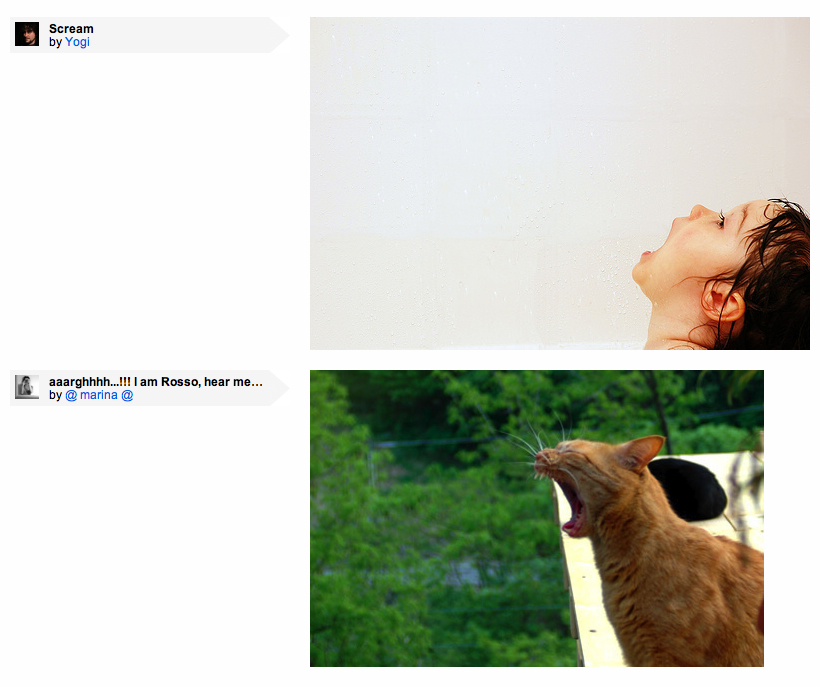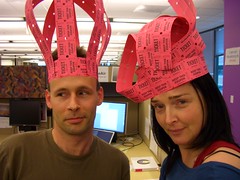Fake Subway APIs
http://fakesubwayapis.appspot.com/
This is just a little thing, a small piece of plumbing, to facilitate next month's Thing (with the Stuff)
and it's pretty much what it sounds like. It doesn't even do much right except return the name of a subway, or train, station for a short code.
Like this:
# GET http://fakesubwayapis.appspot.com/bart/getinfo/24th <rsp stat="ok"> <station code="24th" service="bart"> <url>http://www.bart.gov/stations/24th/</url> <name>24th St. Mission (SF)</name> </station> </rsp>
So far there are only four supported lines: the BART in San Francisco, the STM in Montreal, the Underground in London and the National Rail Service in the whole of the UK. The reasons why are two-fold: They have unique short code for each station and they have corresponding web pages for each one of those identifiers.
At the two extremes of getting it
are BART with lovely, detailed Places-style pages for each of the stop in their network and Transport For London which requires a handful of work-arounds, and shims, to account for the fact that there are only arrival and departures pages for station-plus-line combinations.
What they all share though is a lack of an API so, over the weekend, I banged out an AppEngine thingy that simply wraps a bunch of static lists in plain-vanilla XML-over-HTTP glue. I have two hopes for Fake Subway APIs: 1) That they be replaced by real-live APIs operated by their respective transit services 2) That, in the meantime, people submit patches and data (geo information, for example) and help to shape the kinds of properly maintained APIs that we can hope to use in the future.
As usual, the source code is available for poking on the GitHub: http://github.com/straup/gae-fakesubwayapis
This blog post is full of links.
#fakesubwayapisBurning Man 2009 Tiles
A year ago, when Dan and I were first thinking about adding custom Flickr map tiles for Burning Man we wondered what we would do in a year's time. How would we deal with the mechanics of historical tiles, especially ones for a location
that physically moves by a not insignificant amount every year?
As usual, we punted. After all we had a year to figure it out.
And then a year rolled around and Mikel and I were sitting on a train in Holland, unaware that we were travelling in the wrong direction, happily talking about the Burning Man (Earth) 2009 APIs and how we could wire them up and do machine tags extras magic on Flickr. Which has nothing to do with map tiles, really. It's just a nice story.
It proved to be a bit more cumbersome to grab the tiles this year, as there were distractions and other hiccups on both sides, so we lost a bit of the excitement by not having them live the day Burning Man started (not that anyway really posts their photos from the Playa).
What we did do was work out (read: even more bubblegum and duct tape) how to toggle the map tiles displayed based on whether a photo was taken in 2008 (green tiles!) or 2009 (yellow tiles!)
I don't know if it's the first time-aware map tile set
like Mikel said but I'm glad we're doing it. There's still lots of work to do with all of this stuff, but at least it's a start.
This blog post is full of links.
#burningmanThe Mirror Projectization of Fli... I Mean, Galleries!
We launched Galleries on Monday.
Five days later there were 25, 000 (and counting) galleries.
For as long as Galleries took to get out the door it was also a deliciously fun project to work on. Whether it's the scale of our dreams or just because everything is so much bigger now, projects can sometimes feel overwhelming on good days and like moving mountains on bad ones. It's worth it (on the good days, anyway) but Galleries, done with a fierce eye towards simple
, was a nice echo of of earlier times.
There are plenty of things left to do with Galleries but this feels like a good place to start (or stop, for a while) and to step back and watch what kind of magic users make of it. So far it's been delightful. Galleries were designed to allow, and encourage, users to curate other people's stuff but to do so with a constraint (a maximum of 18 photos per gallery) that would serve to highlight the relationship between each one of the photos. After that, it's up to each user to decide what their galleries are about whether it's squirrels or outer space or, if you're Mike Montiero, bloody nipples (yes, bloody nipples).
Reading through the comments on galleries and watching people Twitter about how excited they are to be included in other people's galleries is the icing on the cake.
These are a few of my favourites, spotted in the first days since lauch:
Finally, this one was extra special for me and Heather having built and tended to the Mirror Project (which I've been known to describe as Flickr, with no ambition
) so many years ago. I hope you'll forgive me this one small indulgence:
Hats off to Adrienne, Heather, Jude and Shanan. It was grand!
This blog post is full of links.
#galleriesSuggestify
Suggetify is this month's Thing (with the Stuff)
.
The Thing being the ability to suggest geotags for other people's photos on Flickr (which I guess makes the Stuff the part where it runs as an API application on top of AppEngine which, in turn, was the genesis for the gae-FlickApp library). It lives here:
It is still clunkly around the edges and lacks polish and proper UI-love but it does work and after a couple months of tiresome hand-wringing about not finding the time to make the shiney-shiney I've just decided to push it out the door.
Here's the short version:
The long version is over here:
http://suggestify.appspot.com/example
The in-between version goes something like this:
- Users sign up (and in) using their existing Flickr accounts.
- Suggesions are added by selecting another user's photos from a carousel and then positioning cross-hairs on a map. At the moment there is no magic drag-and-drop UI love.
- Suggestions are stored on the site, pending review of the actual photographer. This is one of the stickier problems to work out still: How to notify another user that someone has added a suggestion to one of their photos without being spamtasitic about it? For now, I've opted to be more conservative than not which means that, in many cases, user A will need to tell user B that they've added a suggestion. User B, if they choose, can set up an email address where they'll be notified of new suggestions but otherwise this is very much a loose end to be sorted out. Suggestions, no pun intended, are welcome. Photo owners are notified of pending suggestions by (Flickr) comments left on the behalf of the suggestor or by email notifications. The details are described below but the short version is that both may be opted-out of.
- A user whose photo has been suggestified may choose to approve or reject the suggestion or even
block
the user from adding any more suggestions to their photos. A user may also choose to prevent anyone from suggesting locations for their photos. They'll still need to sign up for the site, so that we can validate who they are, but after that they never need to come back if they really want nothing to do with the project. - If a suggestion is approved and the geo information is public then a
geo:suggestedby=machine tag is added to the photo. This provides a useful marker to indicate which photos were geotagged with suggested locations and a little bit of recognition and thanks for the person doing the suggestion. Here are all the photos tagged geo:suggestedby= so far. - There are conversations at to provide facilities to make it easier for the site to work with (trusted) robots. It's a pretty simple model so the only thing should be for me and the robot farmers to write some code.
As best I can tell there aren't any glaringly obvious bugs, although so far this is has only really been tested in Firefox. There is a list of currently known knowns that will be updated as thing are fixed (or discovered):
http://suggestify.appspot.com/about#known
Suggestify's Achilles' heel is that it's still very difficult for people to find out that someone has suggested a location for their photos. Basically the suggestor needs to tell the photo owner and/or the photo owner needs to already be signed up to Suggestify and have set up email notifications for new suggestions. Another obvious way to let people know would be to post a comment on the photo page on behalf of the the suggestor. Talking to people this seems to be the obvious approach but to start I've opted to be more conservative than not about this sort of thing, mostly because I don't want Suggestify to seem like a spamtastic nag.
Update: I have started working changes to allow for notifications through comments. The easy part is adding the comments, that took all of five minutes. The harder part, and the reason it may take another couple of days to deploy, is making sure that photo owners can opt-out of the feature and doing the right thing with regards to Flickr Auth tokens: You need a token with write
permissions to leave comments using the Flickr API but that shouldn't necessarily be required for someone who just wants to make a suggestion (and only needs a read
token to prove who they say they are on Flickr) and doesn't care about adding comments.
Update (my update): After some convincing I have enabled comment notifications, by default, with the ability for photo owners to opt out. Here's what the site says about it:
When someone suggests a location for another person's photo Suggestify tries to post a (Flickr) comment with a handy link back to the suggestion on the suggestor's behalf. Like this:

Photo owners may choose to opt-out of comment notifications entirely even if they continue to allow people to suggest locations for their photos. They may do this because they've enabled another notification mechanism and/or because they'd rather not have
broadcaststyle comments added to their photos. It may make it more difficult for a photo owner to find out about a suggestion but that is a photographer's prerogative.(It's also possible that the suggestor doesn't have permissions, on the Flickr site itself, to add comments.)
The ability to leave a comment requires that the suggestor grant Suggestify
writeaccess to their Flickr account. That's because, in Flickr API terms,writemeans the ability to modify a photo — adding a comment for example — as that user. If a user (making suggestions) prefers that Suggestify only have areadtoken for their account then they can still suggest locations comments won't be added and the recipient will need to be notified by other means.Users may also configure Suggestify to send email notifications when new locations are suggested for their photos.
Both comment and notifications may be configured the settings tab on the site.
I've also posted the source code for the site over on the GitHub: http://github.com/straup/gae-suggestify
I'm doing this because I would love for people to help make this better whether it's by submitting patches specific to Suggestify or by setting up their own (private, semi-public, whatever) instance running on their own servers (remember though this is still a Google AppEngine thingy which hasn't been tested on AppDrop).
Talking to people it seems clear that there's a real desire for the ability to suggest locations for other people's photos (Flickr Commons, anyone?) This is what I can offer today, warts and all, but hopefully people will find it useful enough to bother investigating and building on.
If nothing else, it allowed Neb to tell me where this video in Amsterdam was shot!
Meanwhile, obvious questions will remain unanswered.
This blog post is full of links.
#suggestifyI Was That Guy
I was that guy. Who cancels at the last minute.
I was planning to attend Conflux this year and was scheduled to do ... something for the big DIY Conflux City event on Sunday. I submitted a proposal to do a talk about Clustr and Flickr-derived shapes we've been working on asking the question What else could the tools and software we've developed be used for?
The software that generates those representations was designed to be general enough to use with any dataset consisting of a set of latitudes and longitude. Given the chance, what are the dinner-time, war-time and drunken kitchen-party tories that all the other places we have known would tell? What are the shapes of history?
Conflux seemed like the ideal place to ask those kinds of questions and I was looking forward to the challenge of encouraging an entirely new audience to think of Clustr that might be useful to the work they are doing. I was even looking forward to the challenge of figuring out where, and how, to do a presentation outside the traditional four walls and a projector
. I joked about doing a walking-tour, stand-up Bob-Dylan style presentation with big cardboard slides on the High Line.
Circumstances dictated, though, that by the start of the week I had barely even looked at the festival schedule let alone moved beyond mental sketches of what I was going to say, or where. Launching features and fixing the inevitable bugs that pop up afterwards all while moving house and managing the daily chaos of life at the same time will do that to you.
So, on Wednesday I finally had to admit defeat and write the organizers to tell them I wouldn't be attending.
If you're anywhere near New York City this weekend you should go in my absence. Conflux is not without a healthy dose of goofy but every time I've gone I've enjoyed it, on measure, and there's always been a seed planted during the festival that seems to germinate a few months later.

I suck.
This blog post is full of links.
#thatguy